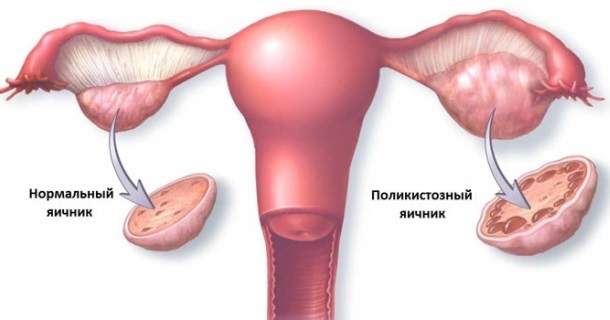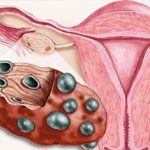Polycystic syndrome - a serious pathology, a result of disruption of the ovaries, adrenals and pituitary gland of the brain. Today this disappointing diagnosis is heard by many women in their address, but in most cases this is a "strained" pathology. Classical polycystic is almost always manifested by a combination of pathological conditions: a change in the ovaries, imbalance of sex hormones, overweight and insulin resistance. Ignoring the problem will soon be felt by infertility, cycle failure, diabetes mellitus and other troubles. How to cure polycystic ovary? Can I get rid of the problem forever and how?
What threatens to ignore the problem
Today there is no consensus and reliable data on the causes of polycystic ovaries. Accordingly, there is no radical treatment of this pathology. Everything you can rely on is a huge clinical experience of generations. Speaking about the treatment of polycystic ovaries, one can only bear in mind the elimination of some of the current troubling women's symptoms, as well as the prevention of menacing diseases in the future.
But do not ignore pathology at all: the basis of the ailment is a violation of the hormonal balance in the body, and this is a risk factor for malignant diseases of female genital organs. And just a regular observation from a gynecologist is not enough. To maintain health, complex treatment is necessary.

Polycystic ovary syndrome
Consequences of untreated polycystic ovary
PCOS can exist and develop as a separate pathology, but it can also appear as a consequence of other diseases. Most often, polycystosis is caused by:
- disrupting the thyroid gland, especially of an autoimmune nature;
- the pathology of the adrenal glands with increased production of male sex hormones;
- disrupting the pituitary and hypothalamus, changing the cyclic release of hormones as early as adolescence;
- hereditary diseases associated with a deficiency of certain enzymes involved in the metabolism of sex hormones.

Disorder of the menstrual cycle
Polycystic is characterized by an increase in the level of estrogens and androgens, a decrease in the hormones of the second phase of the menstrual cycle. All this leads to an elongation of the gap between the monthly. The most favorable option, when the cycle is not more than 60 days. The longer it is, the more complicated and neglected polycystosis, and the probability of the consequences of the ailment is greater.
Infertility
Trying to get pregnant, many girls are constantly looking for an answer to the question of whether polycystosis of the ovaries can be cured and finally become a mother. Indeed, one of the mechanisms of the development of pathology involves the violation of ovulation, more precisely, its almost complete absence. As a result, many small follicles are formed in the ovaries, which could not grow to the dominant one and release the egg.
Development of genital tract pathology
Girls suffering from polycystic disease are most dangerous from the point of view of developing various diseases, hyperestrogenemia. The body of the uterus and the endometrium are most sensitive to this. As a result, fibroids of different sizes and locations are formed. There is also hyperplasia of the endometrium and polyposis. And this all leads to uterine bleeding.
If you ignore these facts, polycystosis can indirectly lead to cancer of the uterus body. That's why women suffering from this pathology should regularly undergo pelvic ultrasound, aspiration biopsy or, if necessary, scraping the cavity.
Estrogens also increase because 70% of girls with polycysticosis have excessive body weight. And adipose tissue is the source of estrogens. It turns out a vicious circle, which is not so easy to break.

Insulin resistance
Over time, almost all women reported a decrease in the sensitivity of cells to insulin. As a result, develops type 2 diabetes. It is not always possible to detect it by the fasting glucose level, the most informative is the performance of the tolerance test.
Obesity
As a result, in women with PCOS a metabolic syndrome is formed. Excess estrogens and androgens change the intensity and direction of metabolism, as a result of which the body begins to deposit stocks in the upper body area. One of the symptoms of the metabolic syndrome is the waist circumference more than 80 cm. Obesity affects up to 80 - 85% of girls with polycystic disease.
Hirsutism
Increasing androgen stimulates excess hair growth in the "male" zones: on the inner thighs, along the white line of the abdomen, over the upper lip, on the chin, etc. This causes a significant cosmetic defect and psychological discomfort in the fair sex.
Dysfunction of other endocrine organs
The functions of other endocrine organs are closely related to ovarian function. Progression of polycystosis and its consequences ultimately leads to a malfunction in the thyroid and pancreas, adrenal glands, and others.
Treatment method
Can polycystic ovaries be cured? Probably not. You can only minimize its some manifestations, temporarily eliminate the violations, and reduce to a small percentage the likelihood of developing malignant diseases. It is these areas that underlie the therapy of polycystic ovary.
Changing diet and physical activity level
No matter how trite it may sound, but proper nutrition and exercise are very important in polycystic ovaries. And this should not be a temporary measure, but a way of life.
The diet, enriched with fresh fruits and vegetables, will help to avoid deficiency of vitamins and microelements. This is the prevention of the development of various diseases - from the menstrual cycle to the oncological pathology. Particular attention should be paid to vitamins A, E, C, group B, selenium, folic acid.
The purpose of nutrition is to stop a progressive body mass gain. This, in turn, will not close the vicious circle of estrogens - obesity - the pathology of the uterus.
In addition, you can take a variety of complexes. But they should also be selected correctly, better for the doctor's prescription. Many studies show that digestibility of vitamins and minerals in combination can be worse than sequential use.
Hormone therapy
Often hormones are used for polycystic ovaries. They are used for several purposes:
- for the normalization of the menstrual cycle;
- to combat infertility;
- for the prevention of the effects of hyperestrogenemia;
- to reduce the effect of elevated levels of androgens;
- for regulation of blood sugar level.
Oral contraceptives are most often prescribed. Their choice depends on the main clinical manifestations of polycystosis. So, drugs like "Yarina" with a pronounced antiandrogenic effect, are most popular. Today on sale there is a similar, but softer means - "Jess".

But there is a great advantage of such hormonal drugs. First, the production of its own estrogens and androgens decreases. And this means that the risk of developing uterine fibroids, endometrial hyperplasia and polyps, as well as malignant diseases is significantly reduced. To achieve this, they will take many years.
As a rule, most often polycystosis is revealed when a woman does not get pregnant. Indeed, in the absence of ovulation, the chances of conception are sharply reduced. The output in this case is also the appointment of hormonal drugs, but another spectrum. Used induction ovulation, the most common - "Clomiphene."The dose and the scheme of application should be determined by the doctor, taking into account the severity of the pathology.
Also, with polycystic insulin resistance almost always occurs. To prevent this condition can only be a correction of nutrition, physical loads. With a small intake of glucose and a high level of its utilization by the muscles, insulin resistance will not appear. But in some situations it is still necessary to use drugs that increase the sensitivity of the cells of the body to glucose. The most effective and safe is Metformin. Clinical experience shows that its regular use sometimes leads to spontaneous normalization of the cycle, reduces the progression of the disease. Also, against the background of his reception, the induction of ovulation with clomiphene is more effective even in girls who have not previously been sensitive to this drug.
Operative techniques
Polycystic ovaries are surgically treated only to increase the likelihood of ovulation for subsequent pregnancy. Classical operation - wedge-shaped excision of the ovaries. The fact is that under polycystic disease they are significantly enlarged and covered with a dense membrane, which is believed to interfere with the growth and maturation of follicles. During the operation, it is partially removed.
The probability of pregnancy increases dramatically in the next 3 to 4 months, and then again progressively falls - the ovaries again "overgrow".Also during this period, sometimes stimulation of ovulation is carried out, which greatly increases the probability of successful conception.
Such operations can be performed several times, but if the first attempt fails, it is worthwhile to think about other ways of solving the problem.
Cosmetic procedures
Not always with the help of drugs you can eliminate all visual manifestations of the disturbed hormonal background. In many cases, you have to additionally use the services of beauty salons. For example, remove excess hair. Laser or other types of hair removal will help remove coarse hair that has already grown. And hormonal preparations, having corrected a background, will not allow them to appear anew.
Physiotherapy
Regular physical therapy( only with the permission of a doctor) is also useful in polycystic disease. Massage of various parts of the body, as well as a variety of water procedures are welcomed. It can be fitovanny, Charcot's shower. Useful hydromassage and just regular visits to the pool.
Is polycystic ovary treated? PCOS is an undeveloped pathology, and there are no ways of radical elimination of it. But the accumulated knowledge and experience show that this disease should not be neglected. Only a complex and competent treatment throughout virtually the whole of life will help to avoid the unpleasant consequences of pathology, including cancer.

 We recommend reading the article on monthly for polycystic ovaries. From it you will learn about the disease and its effect on menstruation and the duration of the cycle in a woman, whether it is necessary to cause a period in polycystosis, as well as the treatment of the disease.
We recommend reading the article on monthly for polycystic ovaries. From it you will learn about the disease and its effect on menstruation and the duration of the cycle in a woman, whether it is necessary to cause a period in polycystosis, as well as the treatment of the disease.